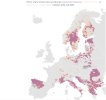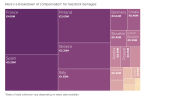RJE
Member
- Time of past OR future Camino
- Camino Frances 8/21/24 to 9/20/24.
| Remove ads on the forum by becoming a donating member. More here. |
|---|
Wow wow wowThis made for an exciting morning for me and a few pilgrims in the hills just before El Acebo today.
A Spanish lady took charge and had us sit down…not sure that was the right course of action, but it calmed him down until he moved on.
Nature is beautiful, but be mindful you are in nature.
View attachment 177550
View attachment 177551
View attachment 177552
Nice!This made for an exciting morning for me and a few pilgrims in the hills just before El Acebo today.
A Spanish lady took charge and had us sit down…not sure that was the right course of action, but it calmed him down until he moved on.
Nature is beautiful, but be mindful you are in nature.
View attachment 177550
View attachment 177551
View attachment 177552
Wow..... and a great close-up!This made for an exciting morning for me and a few pilgrims in the hills just before El Acebo today.
A Spanish lady took charge and had us sit down…not sure that was the right course of action, but it calmed him down until he moved on.
Nature is beautiful, but be mindful you are in nature.
View attachment 177550
View attachment 177551
View attachment 177552
That looks exactly like our old (now deceased) German shepherd/Alsatian.This made for an exciting morning for me and a few pilgrims in the hills just before El Acebo today.
A Spanish lady took charge and had us sit down…not sure that was the right course of action, but it calmed him down until he moved on.
Nature is beautiful, but be mindful you are in nature.
View attachment 177550
View attachment 177551
View attachment 177552

At least two of these photos are also in a FB post by someone called Ken, but maybe you are the same person @RJE or shared photos.
A healthy wild wolf would never get that close to people, they would be long gone before you'd ever even known they were there. ...
Such attacks on humans are extremely rare and most involve wolves infected with rabies, a viral disease that affects the central nervous system. A rabid wolf will typically make multiple assaults without consuming the victims.

Yes, Ken’s wife shared with me. He took the pics from a distance. I was seated with this guy 3 feet from me. Frozen.At least two of these photos are also in a FB post by someone called Ken, but maybe you are the same person @RJE or shared photos.
A healthy wild wolf would never get that close to people, they would be long gone before you'd ever even known they were there. It's a young wolf so maybe something untoward has happened to the parents who it would rely on for food. As @Bog526 says best to admire from a distance and certainly not feed it as a wolf that becomes accustomed to humans will either end up in the zoo or disappear by some other means.

A very isolated occurrence and certainly not something associated with wolves or canines in general. Currently, they think it is one individual wolf or wild dog that is responsible. We also have to remember before labeling a whole species as killers that humans are far more destructive and dangerous to each other than any wild animalThere is an recent article about wolves in India and this is the stand out comment about killing children and others. Makes you think twice about being near one.

Uttar Pradesh: The child-killing wolves sparking panic in India
Since April, wolf attacks have terrorised villages near the Nepalese border, killing nine children.www.bbc.co.uk
Articles in Spanish press are always sensationalised one way or another. It is true there are always conflicts, but unfortunately much of the time it is worth cattle left unguarded which is no longer compatible with returning wildlife - but the solution they always want is to kill the wolves as opposed to adapt in a better way. In Le Culebra where wolves clung on after been wiped out across the rest of Spain they have hardly any problems with wolves as the traditional way of tending to their animals never truly died out. Le Culebra has one of the highest densities of wolves in all of Western Europe.There was an article today in " La Voz de Galicia" about a real problem with wolves one km from O Pino ( Camino Frances). Wolves are killing a lot of cattle there.
I am in favour of wolves. Sometimes there are similar news in La Voz but I never mentioned one here. In this ocasion was becase it happened only one km from O Pino ( on the C.. Frances near Santiago) and this is a forum about the camino.Articles in Spanish press are always sensationalised one way or another. It is true there are always conflicts, but unfortunately much of the time it is worth cattle left unguarded which is no longer compatible with returning wildlife - but the solution they always want is to kill the wolves as opposed to adapt in a better way. In Le Culebra where wolves clung on after been wiped out across the rest of Spain they have hardly any problems with wolves as the traditional way of tending to their animals never truly died out. Le Culebra has one of the highest densities of wolves in all of Western Europe.
There is a much bigger problem with domestic dogs, but of course this does not sell papers.
Apologies @Pelegrin my post was in no way aimed at you. These headlines are a regularity for anyone who reads Spanish news so it would make no difference if they are posted or not. I was just trying to add a bit of context for anyone who might think Spain is becoming overrun with man-eating wolves!I am in favour of wolves. Sometimes there are similar news in La Voz but I never mentioned one here. In this ocasion was becase it happened only one km from O Pino ( on the C.. Frances near Santiago) and this is a forum about the camino.
one of my two or three favorite creatures.This made for an exciting morning for me and a few pilgrims in the hills just before El Acebo today.
A Spanish lady took charge and had us sit down…not sure that was the right course of action, but it calmed him down until he moved on.
Nature is beautiful, but be mindful you are in nature.
View attachment 177550
View attachment 177551
View attachment 177552
I have encountered wolves in Italy several times while walking in Abruzzo and Umbria, two central Italian regions. Usually they were walking alone.I am an old Spanish mountaineer and never saw one in the wild in my life.
I am inclined to concur with you. Wolves are among the few apex species in the food hierarchy that can attack prey much larger than themselves, and have unprecedented physical endurance.Doubtful that a wolf would try and take on a group of humans unless it was rabid. I personally would have been more inclined to want to scare the wolf away by yelling, banging together trekking poles, blowing on whistles etc so as to avoid any further contacts with people. For the wolf's sake.
There was an article today in " La Voz de Galicia" about a real problem with wolves one km from O Pino ( Camino Frances). Wolves are killing a lot of cattle there.
Well.... they DO have to eat!!!! And that is the way of the Nature. People are killing lots of cattle too, should we shoot them.... oh wait... we DO DO that, sometimes for no reason at all.I wish this thread could be cut now. So much wow-ing and "they kill"-ing. Please leave these creatures alone. It is NOT a good thing that you see them! Go to one of your heartbreaking zoos you might have if you need to. Leave nature alone and stop blame it!
There is no evidence for this statement whatsoever and you're probably a million times more likely to get killed by a randy cow than devoured by a pack of wolves.Alone they are quite guarded, but a pack of hungry wolves can pose a great danger to a passing human.
The real problem is: is it a good idea to encourage wolves to come closer to the trails and feed them? Or is it better to keep them away (without hurting them, of course)?There is no evidence for this statement whatsoever and you're probably a million times more likely to get killed by a randy cow than devoured by a pack of wolves.
I am not an English native speaker. Maybe the word " kill" is too strong for that case. But I thought that " hunt" was not suitable for the case of cattle.Well.... they DO have to eat!!!! And that is the way of the Nature. People are killing lots of cattle too, should we shoot them.... oh wait... we DO DO that, sometimes for no reason at all.
Animals were here long before we were so yes leave them alone!
BTW my wife took a look at the photo and said that it's a wolf-dog
Wow, I'd heard there were some but have never encountered one , yet.This made for an exciting morning for me and a few pilgrims in the hills just before El Acebo today.
A Spanish lady took charge and had us sit down…not sure that was the right course of action, but it calmed him down until he moved on.
Nature is beautiful, but be mindful you are in nature.
View attachment 177550
View attachment 177551
View attachment 177552

 www.facebook.com
www.facebook.com
looks like the same guy (or a girl.... Im not too versed in wolves' sex identification)Another report of a sighting of a wolf near El Acebo on Facebook this afternoon.

Camino de Santiago All Routes | Met the wolf 1km up the hill from El Acebo. | Facebook
Met the wolf 1km up the hill from El Acebo.www.facebook.com
Seems very likely. Very unusual for a wolf to approach people in this way. I fear that its days may be numbered if this continues.looks like the same guy (or a girl.... Im not too versed in wolves' sex identification)


 :
:WOW!Livestock attacks by wolves in recent years in 19 EU countries:
Quite some time ago on a different thread I quipped that "Human is the most dangerous animal on this planet" but that does steer the conversation into a murky grey zone so we should just leave it alone.You can now understand why in an early post I ask to keep these animals away from us.
Because WE are dangerous.

Ok, that’s an attempt at making a joke … I am not sure how successful it is with readers of this thread …WOW!
All European wolves have immigrated to Spain.... and as per origina post it is conceivable that they all slowly becoming Pilgrims on Camino!
That's interesting. I guess, though, that the Germanic toponymic placenames do not refer to places where there were wolves but rather to places where a person with this name lived or owned the place? The endings -ulf, -olf or similar stand for "wolf" and can be found in numerous Nordic and Germanic male names.In Galicia there are Galician toponymy with Lobo ( wolf) like Castiñeira do Lobo, Fonte, Forca, Covas and Pouta do Lobo, Lobeira. And Germanic toponymy like Gandulfe, Tresulfe, Randulfe, Friolfe, Frexulfe.
Do you know how "recent" are those "recent years"? I read the article at Politico you linked but I couldn't find theI see that this thread is no longer a "Live on Camino" thread because @RJE has already arrived in Santiago. So: Politico has a number of graphics that illustrate some of the issues around the wolf population in Europe which I found interesting.
Where permanent wolf populations are (in 2012-2016; I think they have spread some more, for example into the Netherlands and Belgium). You can clearly see the concentration in the north-west part of Spain:
View attachment 178039
Livestock attacks by wolves in recent years in 19 EU countries:
View attachment 178040
Government payments to farmers as compensation for livestock damages due to attacks by wolves in the same 19 EU countries:
View attachment 178041:
It's important to understand the severity of the problem.incident-based livestock damage data across 21 countries for the years 2018, 2019 and 2020, during which 39,262 wolf-caused incidents were reported from 470 administrative regions.
Yes, but " ulfe" seems to be the plural of wolf and it is strange a person having a name with wolf in plural. F. ex. Friolfe and Frexulfe could mean free wolves. Anyway even assuming that this toponymy are people names reveals fascination of those people about the wolf. I am curious to know why there isn't toponymy like this in Spain out of Gallaecia. Where Suebi more fascinated about wolves than Visigoths? Or maybe the Visigoths spoke already Latin when they arrived in Spain.That's interesting. I guess, though, that the Germanic toponymic placenames do not refer to places where there were wolves but rather to places where a person with this name lived or owned the place? The endings -ulf, -olf or similar stand for "wolf" and can be found in numerous Nordic and Germanic male names.
I am not sure that I understand what you mean by not being able to find "the graphs" there. As to the data for "Livestock attacks by wolves in recent years in 19 EU countries" and the graph in my earlier post, the Politico article contains a link to the document where they pulled their data from. So I checked: The data come from the EU member states, actually 24 in total but not all of them provided detailed figures, and depending on the country the data refer to the year 2022 for the majority of countries but some countries provided data for the year 2021 and other countries for the year 2020 or even 2019 and one country for 2017. Hence summarised as "recent years" in the Politico article.Do you know how "recent" are those "recent years"? I read the article at Politico you linked but I couldn't find the graphs there.
I am not at all certain of that. Wölfe is the plural of Wolf in the modern German language but I would not conclude from this that it is the plural form in old Germanic languages or in placenames that went through orthographic changes over the centuries.but " ulfe" seems to be the plural of wolf
Technically wolves are present in number from Burgos all the way to Santiago in terms of the CF.Where on the Camino Francés a Camino pilgrim might encounter wolves
The recent video and photos are highly unusual behaviour for a wild wolf. It is likely this wolf is young and has been separated from it's pack and is unable to hunt wild prey itself (whether they were killed or they pushed this wolf out who knows). It is also likely given it's close proximity that people have been feeding it.as close as shown in the video clip and on photos in this thread
Nothing - in the highly unlikely event of a wolf being so close you just carry on as normal, don't run and don't turn your back until you feel safe. Same as you would do with a domestic dog you don't want to get friendly with.what to do and not to do
I am trying to refrain from commenting even more than I've already commented - not at all easy for me
Not quite correct (at least not for the last 4 years).I am trying to refrain from commenting even more than I've already commented - not at all easy for me- but reading more than one article about this was interesting.
The linked article does not mention Spain or the fact that even when the status of Canis lupus is changed from "Strictly protected" to "Protected", i.e. when this name is moved from the list in Appendix II to the list in Appendix III in the relevant legislation, it won't change a thing in Spain.
Why? Because Spain made a reservation in 1986, i.e. they won an exception. Quote from the Bern Convention under the heading "Spain": A reservation is made concerning the fauna species Canis lupus, Sturnus unicolor, Lacerta Lepida and Vipera latasti, Carduelis-Carduelis, Carduelis Chloris, Carduelis Cannabina and Serinus Serinus, included in Appendix II as "Strictly protected fauna species", which will be considered by Spain as "Protected fauna species" enjoying the régime of protection provided for by the Convention for the species included in Appendix III.
It appears to me that the other countries now want what Spain already has.

 www.facebook.com
www.facebook.com
The short answer is: terrestrial rabies is considered to be eradicated in Spain since 1978.Does rabies exist in Spain
Thank you! It is good to read that rabies is considered eradicated - I found it puzzling that no one else had mentioned it in any of the comments about the wolf. I am intrigued to realise how powerful some childhood fears can remain, after so many, many years. **I was also interested to read about the incidence in Italy and Greece (and I learned a new word: "murcielagos!").The short answer is: terrestrial rabies is considered to be eradicated in Spain since 1978.
The best long answer about the current situation in Spain is probably on this website of the Spanish government:


